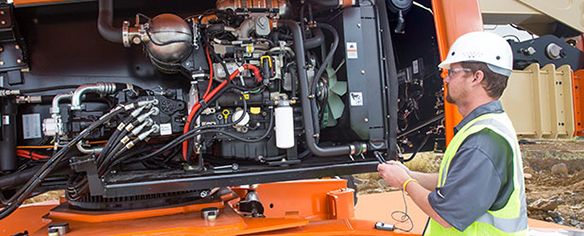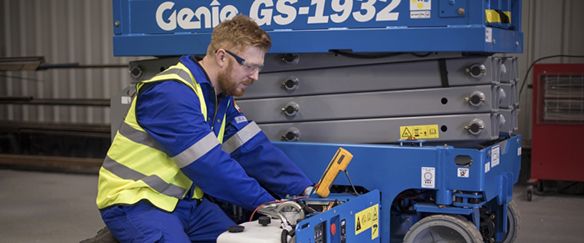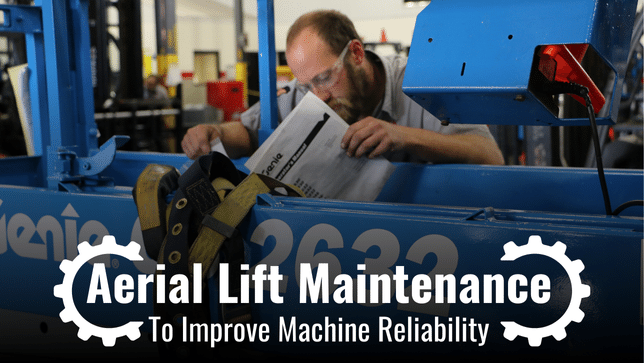If your aerial lift is running smoothly, your entire operation runs smoothly. Conversely, a faulty aerial lift can bring the entire work site to a standstill. To help prevent this issue, here are some top aerial lift maintenance practices to help you enhance the reliability and efficiency of your equipment.
PERIODIC AERIAL LIFT MAINTENANCE
Scheduled inspections and preventative maintenance are the number one way to help guarantee the best performance from your aerial lift. These practices help identify problems at an early stage before they down your unit.
For example, minor damage to a component, like a leak in a hub that will grind up if unchecked. This will ultimately cause damage in a boom tube and become a crack. Minor damage could also be a neglected cable adjustment that allows a cable to jump off the sheave. These are all preventable issues that are cheaper to fix the earlier they are spotted.

AERIAL LIFT MAINTENANCE CHECKLIST
Regular general maintenance is crucial to keep your aerial lifts running smoothly and safely. A well-maintained lift not only ensures the safety of your workers but also extends the equipment’s lifespan. Here’s a checklist to help you stay on top of your aerial lift maintenance:
- Daily inspections: Before each use, operators should conduct a visual inspection of the lift, checking for any visible damage, leaks, or worn parts. Test the controls, brakes, and safety devices to ensure they’re functioning properly.
- Weekly inspections: Once a week, perform a more thorough inspection of the lift. Check the hydraulic fluid levels, battery condition, and tire pressure. Lubricate moving parts and clean the lift to prevent debris buildup.
- Monthly inspections: Every month, inspect the lift’s structural components, such as the boom, scissor arms, and platform. Check for any signs of wear, cracks, or corrosion. Test the emergency lowering system and ensure all safety decals are legible.
- Annual inspections: Hire a certified technician to perform a comprehensive annual inspection of your aerial lift. They’ll check the lift’s electrical systems, hydraulic components, and structural integrity. This inspection is essential for maintaining compliance with OSHA and ANSI standards.
If you’re concerned about aerial lift safety (and you should be!), keep a keen ear out for suspect sounds, pay attention to wonky vibrations, and keep an eye on performance quirks. Should you notice anything off, call in a certified pro to inspect and rectify the issue before anybody operates the lift again. By partnering with a reliable material handling equipment service provider, you can ensure your lifts remain safe and efficient for years to come.
A great resource for proper aerial lift inspections can be found here (OSHA Aerial Lift Fact Sheet). However, It is critical that you consult with a certified technician to help develop a comprehensive inspection and maintenance checklist tailored to your specific needs and to ensure compliance with all applicable regulations and standards.
OEM PARTS
Look to the original aerial lift manufacturer (OEM) for the best ways to keep your fleet running. When replacing parts, the individual costs may seem small, but you know that their impact on a machine’s uptime is enormous.
Replacement parts that aren’t factory-fitted might physically fit, but they may not work as well and often cause downtime. Joysticks, for example, can cause issues – they can be the wrong style that either doesn’t work with your unit, works poorly (operating in one direction but not another), or for a very short period.
Your boom lift or scissor lift should be on the work site when required. So, dealing with downtime and failures caused by parts that aren’t specified for your Genie machine isn’t in the budget or the schedule. Avoided this issue, by using genuine parts purchased from the OEM, like Genie Genuine Parts or JLG Genuine Parts.
Having those parts installed quickly is equally important since waiting for parts to arrive and be fitted is the major cause of unplanned downtime. So, the ability to quickly order and receive OEM parts, along with the age of units serviced by your aerial lift dealer, are important factors for your equipment’s reliability.
COST TRACKING
Tracking the cost of repairs is also an indicator of the aerial lift’s total cost of ownership. An engine failure, or sometimes just a pump replacement, maybe a signal that the cost of ownership curve is no longer sufficiently profitable.
Although some engines may have an advertised life of around 8,000 hours, boom tubes and the chassis don’t wear out unless damaged, so it’s a misconception that machines simply have a standard maximum age or hours of life – these types of parts failures are often a sign of poor maintenance and can signal future issues.

The reality is that following best practices for aerial lift maintenance can save your business a lot of money. By completing the steps outlined in these safety tips, you can positively impact the residual value and on-the-job performance of your booms and scissor lifts.
Read: Aerial Lift Battery Maintenance Tips for a Longer Battery Life
Content provided by Genie, a Terex brand.
